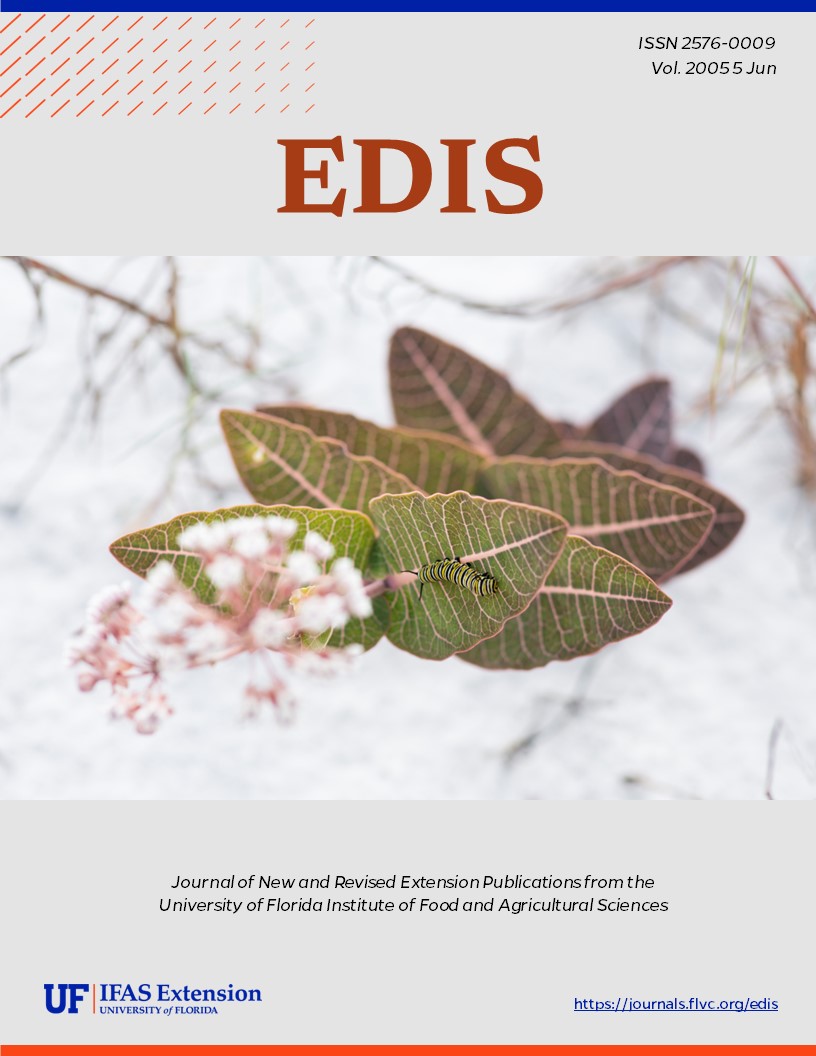Abstract
The Comprehensive Everglades Restoration Plan (CERP) aims to improve water quantity, timing, distribution, and quality of the Greater Everglades System (Figure 1) over the next 35 years (SFERTF 1998). Not only is it the most expensive (8 billion dollars, 1999) and ambitious ecological restoration ever undertaken, but it involves multiple agencies and organizations analyzing natural and ecological attributes to recover the natural system. A critically important but often overlooked aspect of the Everglades is the role of flow--the actual movement of water across the landscape--in creation and maintenance of habitats for Everglades plants and animals. Successful restoration of the Everglades landscape requires a thorough understanding of the role of flow (SCT 2003). This document is CIR1452, one of a series of the Wildlife Ecology and Conservation Department, University of Florida Cooperative Extension Service, Institute of Food and Agricultural Sciences. Publication date: December, 2004.
CIR 1452/UW199: The Role of Flow in the Everglades Landscape (ufl.edu)
References
Craighead, F.C., Sr. 1968. The role of the alligator in shaping plant communities and maintaining wildlife in the southern Everglades. Florida Naturalist 41:2-7, 69-74, 94.
Davis, S.M. 1991. Growth, decomposition, and nutrient retention of Cladium jamaicense Crantz and Typha domingensis Pers. Florida Everglades. Aquatic Botany 40:203-224. https://doi.org/10.1016/0304-3770(91)90059-E
Davis, S.M. and J. Ogden. 1994. Introduction. Pages 3-7. Davis, S.M. and J.C. Ogden (eds.) Everglades, the Ecosystem and its Restoration. St. Lucie Press, Delray Beach, FL.
Douglas, M.S. 1947. The Everglades River of Grass (revised edition, 1988). Pineapple Press, Sarasota, Florida.
Fennema, R.J., C.J. Neidrauer, R.A. Johnson, T.K. MacVicar, and W.A. Perkins. 1994. A computer model to simulate natural Everglades hydrology. Pages 249-289. Davis, S.M., and J.C. Ogden (eds.) Everglades, the Ecosystem and its Restoration. St. Lucie Press, Delray Beach, FL, USA.
Gunderson, L. H., and J. R. Snyder. 1994. Fire patterns in the southern Everglades. Pages 291-306. Davis, S.M. and J.C. Ogden (eds.) Everglades, the Ecosystem and its Restoration. St. Lucie Press, Delray Beach, FL.
Heal, O.V., P.M. Latter, and G. Howson. 1978. A study of the rates of decomposition of organic matter. Chapter 7. Pages 136-159. O.W. Heal, and D.F. Perkins (eds.). Production Ecology of British Moors and Montane Grasslands. Ecological Studies 27. Springer-Verlag, New York, New York. https://doi.org/10.1007/978-3-642-66760-2_7
Johnson, L.C., and A.W.H. Damman. 1991. Species-controlled Sphagnum decay on a South Swedish raised bog. Oikos 61:234-242. https://doi.org/10.2307/3545341
Kolopinski, M.C., and A.L. Higer. 1969. Some Aspects of the Effects of the Quantity and Quality of Water on Biological Communities in the Everglades National Park. Open File Report 69007, United States Geological Survey, Washington, D.C., USA.
Kushlan, J.A. 1993. Freshwater wetlands. Pages 74-127. M.S. Dennison and J.F. Berry. Wetlands: Guide to Science, Law, and Technology. Noyes Publications, Park Ridge, New Jersey.
Lord, l. A. 1993. Guide to Florida Environmental Issues and Information. Winter Park, FL: Florida Conservation Foundation.
Mazzotti, F.J., and L.A. Brandt. 1994. Ecology of the American Alligator in a seasonally fluctuating environment. Pages 485-505. Davis, S.M., and J.C. Ogden (eds.) Everglades, the Ecosystem and its Restoration. St. Lucie Press, Delray Beach, FL, USA.
McVoy, C.W., W.P. Said, J. Obeysekera, and J. VanArman. In review. Pre-drainage landscapes and hydrology of the Everglades.
Mitchell-Bruker, S., D. Childers, M. Ross, L. Leonard, H. Solo-Gabriel, S. Stothoff. 2002. Determining the Role of Sediment Deposition and Transport in the Formation and Maintenance of Tree Islands in the Florida Everglades. American Geophysical Union Spring Meeting 2002.
National Park Service. 1997. Everglades 101: An Introduction to the Ecosystem. Ed. Public Affairs Office. Updated September 9, 1997. www.nps.gov/ever/eco/ever101.htm
National Research Council (NRC). 2003. Does Water Flow Influence Everglades Landscape Patterns? National Academies Press. Washington, DC.
Ogden, J.C. 1994. A comparison of wading bird nesting colony dynamics (1931-1946 and 1974-1989) as an indication of ecosystem conditions in the southern Everglades. Pages 533-570. Davis, S.M., and J.C. Ogden (eds.) Everglades, the Ecosystem and its Restoration. St. Lucie Press, Delray Beach, FL, USA.
Rochefort, L., D.H. Vitt, and S.E. Bayley. 1990. Growth, production, and decomposition dynamics of Sphagnum under natural and experimentally acidified conditions. Ecology 71(5):1986-2000. https://doi.org/10.2307/1937607
Science Coordination Team (SCT). 1997. South Florida Ecosystem Restoration Task Force. www.sfrestore.org.
Science Coordination Team (SCT). 2003. The Role of Flow in the Everglades Ridge and Slough Landscape. South Florida Ecosystem Restoration Working Group. Approved by the SCT: January 14, 2003.
Sklar, F., L. Brandt, D. DeAngelis, C. Fitz, D. Gawlik, S. Krupa, C. Madden, F. Mazzotti, C. McVoy, S. Miao, D. Rudnick, K. Rutchney, K. Tarboton, L. Vilchek, and Y. Wu. 2000. Hydrological needs - effects of hydrology on the Everglades. Pages 2-62. SFWMD. Everglades Consolidated Report, South Florida Water Management District, West Palm Beach, FL, USA.
South Florida Ecosystem Restoration Task Force (SFERTF). 1998. An Integrated Plan for South Florida Ecosystem Restoration and Sustainability: Success in the Making. The Working Group of the South Florida Ecosystem Restoration Task Force.
Stober, J., D. Scheidt, R. Jones, K. Thornton, R. Ambrose, and D. France. 1996. South Florida Ecosystem Assessment Monitoring for Adaptive Management: Implications for Ecosystem Restoration. Interim report. Environmental Protection Agency, Athens, GA, USA. EPA 904-R-96-008.
Tamiami Trail Commissioners. 1928. History of the Tamiami Trail, and a Brief Review of the Road Construction Movement in Florida. The Tamiami Trail Commissioners and the County Commissioners of Dade County, Miami, Florida. 27p.
Trustees. 1881. Articles of Agreement with Hamilton Disston for the Reclamation of the Overflowed Lands in the Valley of Lake Okeechobee and Kissimmee River. In Minutes of the Trustees, Feb. 26, 1881 Meeting. Vol. II (1904). Tallahassee, FL: Trustees of the Internal Improvement Fund.
van Dierendonck, M.C. 1992. Simulation of peat accumulation: an aid in carbon cycling research? Suo 43(4-5):203-206.
VanZee, R. 1999. Natural System Model Version 4.5 Documentation Report. Draft report, South Florida Water Management District, West Palm Beach, FL, USA.

